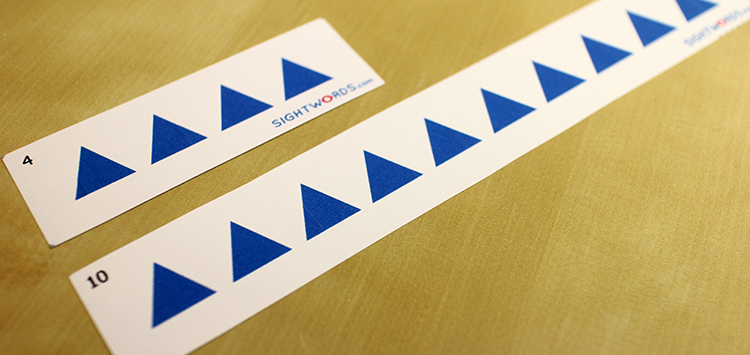C9: Which Sounds Longer?
1. Overview
Compare two words and judge which sounds longer (has more syllables). This exercise will focus on the concept of a word as separate from the thing the word describes. Up to this point we have been using primarily one-syllable words to introduce the concepts of words and sentences. Now it is time for your child to learn that not all words have just one part (syllable).
Which word sounds longer: frog or motorcycle?
2. Materials
Instead of showing written words (because we’re not trying to read yet!), we will use cards with different numbers of triangles on them, with each triangle representing one letter. Print and cut the cards along the dotted line. NOTE: Don’t make the mistake of writing out the letters that spell the words you choose. Doing this defeats the purposed of helping your child hear the differences in word lengths! ↑ Top3. Activity
Video: How to play Which Sounds Longer?
In this game you will select two words of different syllable lengths — for example, grasshopper (3 syllables, 11 letters) and car (1 syllable, 3 letters). Find the appropriate word length cards (11 and 3 triangles), but keep them out of the child’s view. Clearly speak the two words to the child. Have him repeat the words to you, and then ask him to pick which one he thinks sounds longer.
Adult: I am going to say two words to you, and you are going to decide which word sounds longer. Listen to the words: grasshopper and car. Say the words back to me. Child: Grasshopper. Car. Adult: Good. Which word sounds longer? Grasshopper? Or car? Child: Um…car? Adult: Well, a car is a lot longer than a little grasshopper, but I am asking which word sounds longer when you hear it or say it out loud. Let’s try again: Grasshopper. Car. Which word sounds longer? Child: Grasshopper. Adult: Very good! The word grasshopper is longer than the word car. Here, I’ll show you. [Reveal the word length cards.]After he has made his choice, show him the two word length cards. Line up the cards (as in the photo above) to make it visually clear to the child that one is longer than the other. This subtly introduces the concept that the number of letters usually affects the phonological length of a word.
Adult: We use these cards to show how long the words are. Each triangle stands for a letter. Which word looks longer? Child: That one. [pointing to the card with 11 triangles] Adult: Which word do you think that is: car or grasshopper? Child: Grasshopper? Adult: Why do you think that word is grasshopper? Child: Because it’s longer. Adult: Yes, the word grasshopper sounds longer than the word car, and it also looks longer than the word car when you write it out.Start with word pairs where the longer word has three or more syllables (the left column of the word pair list). Once the child has the hang of the game, use some pairs where the longer word has just two syllables. As in the above example, make sure you have some pairs in which the smaller word describes a bigger object. This way, you can tell if your child understands that he is looking for the longer-sounding word or is simply picking the larger object that the word represents. He has to learn to consider the words separate from the objects they represent or their meanings. NOTE: You do not need to count out the syllables in the words yet. That will come later! Also, do not get distracted by counting the letters in each word. We are only concerned right now with “longer” and “shorter,” not exact numbers. ↑ Top
4. Extension
Once your child has been introduced to the concept of syllables, you can return to this game and count the syllables in the words, using the number of syllables to judge which word in the pair sounds longer. Do not use the word length cards with blue triangles to count syllables. (We don’t want the child to get confused between syllables and letters.) Use a different shape and/or color, such as a green rectangle, to represent syllables. ↑ Top5. Variation
Use words from stories your child has been reading lately. Then, after you have taught the syllables lessons, when you read those books again, you can choose some of the words, say them aloud, and reinforce this lesson. As you read, ask the child if he heard any long words in the story. ↑ Top6. Small Groups (2-5 children)
Lesson Objective: Using word length cards as visual aids, children will hear spoken words and determine that the length of the sound of the word is different from the length (size) of the item the word represents. GELDS (Georgia Early Learning & Development Standards): CLL6.4e (This activity establishes the foundation for work with syllables.) Additional Materials: Note: You do not need to use the word length cards.)- optional: plastic tray
Leave a Reply

